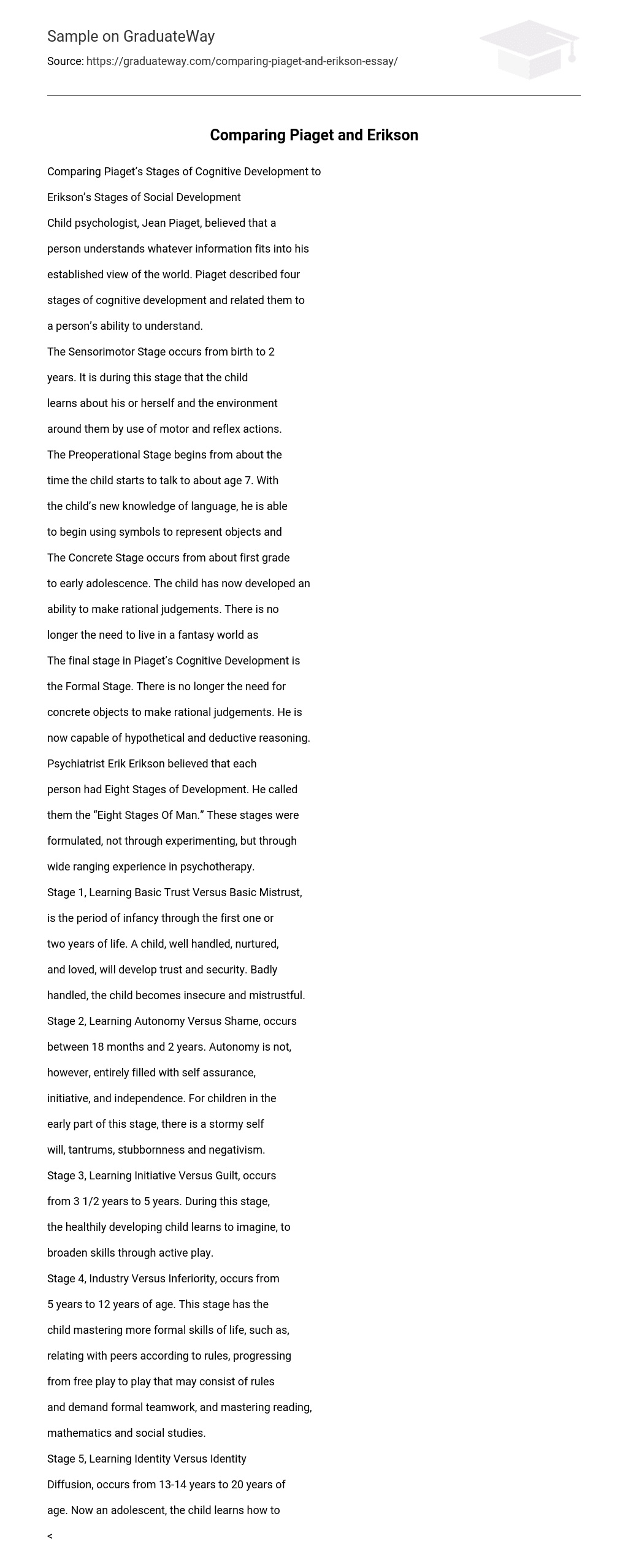Child psychologist, Jean Piaget, believed that a person understands whatever information fits into his established view of the world. Piaget described four stages of cognitive development and related them to a person’s ability to understand. The Sensorimotor Stage occurs from birth to 2 years. It is during this stage that the child learns about his or herself and the environment around them by use of motor and reflex actions.
The Preoperational Stage begins from about the time the child starts to talk to about age 7. With the child’s new knowledge of language, he is able to begin using symbols to represent objects and The Concrete Stage occurs from about first grade to early adolescence. The child has now developed an ability to make rational judgements. There is no longer the need to live in a fantasy world as The final stage in Piaget’s Cognitive Development is the Formal Stage. There is no longer the need for concrete objects to make rational judgements. He is now capable of hypothetical and deductive reasoning.
Psychiatrist Erik Erikson believed that each person had Eight Stages of Development. He called them the “Eight Stages Of Man.” These stages were formulated, not through experimenting, but through wide ranging experience in psychotherapy.
Stage 1, Learning Basic Trust Versus Basic Mistrust, is the period of infancy through the first one or two years of life. A child, well handled, nurtured, and loved, will develop trust and security. Badly handled, the child becomes insecure and mistrustful.
Stage 2, Learning Autonomy Versus Shame, occurs between 18 months and 2 years. Autonomy is not, however, entirely filled with self assurance, initiative, and independence. For children in the early part of this stage, there is a stormy self will, tantrums, stubbornness and negativism.
Stage 3, Learning Initiative Versus Guilt, occurs from 3 1/2 years to 5 years. During this stage, the healthily developing child learns to imagine, to broaden skills through active play.
Stage 4, Industry Versus Inferiority, occurs from 5 years to 12 years of age. This stage has the child mastering more formal skills of life, such as, relating with peers according to rules, progressing from free play to play that may consist of rules and demand formal teamwork, and mastering reading, mathematics and social studies.
Stage 5, Learning Identity Versus Identity Diffusion, occurs from 13-14 years to 20 years of age. Now an adolescent, the child learns how to answer satisfactorily and happily the question of “Who am I?” Most boys and girls experiment with minor delinquency, rebellion, self doubts and so on.
Stage 6, Learning Intimacy Versus Isolation, occurs from 20-25 years of age.
The successful young adult, can for the first time, experience true Stage 7, Learning Generativity Versus Self-Absorption, occurs from 25-30.
This stage has the adult being very generative, both in marriage Stage 8, Integrity Versus Despair, occurs from 30-40 years. He trusts, he is independent and he dares the new.
He is proud of what he creates- his children, his work, or his hobbies. Piaget and Erikson have very different views on the ways a child develops. Piaget’s first stage, birth – 2 years, has the child imitating behavior, exploring their own body and senses. He feels the child, at age 0-4 months, has the basic “out of sight, out of mind” attitude. Erikson, however, feels that the child that is nurtured and loved, will develop trust, security and optimism. Piaget’s stages from 2 years to 4 years, have the child living in a basic fantasy world.
While Erikson’s stage, at this same age, has the child focused on himself. He is oriented to his parents and needs limits, support, and secure environment. Through ages 5-7 years, Piaget notes the same behavior as when the child was 2-4 years, with the added development of concrete mental operations. Erikson notes that the child now identifies with his/her own gender, enjoys group play and maintains The 7-11 years, according to Piaget, are Concrete Operation years. He begins to think rationally and to generalize.
Erikson shows his child continuing his enjoyment in group play and in peer relationships. He is often competitive, impressed by older role models, learns behavior from parents, The years of 12-16 for the Piaget child, show him capable of cognitive problem solving and decision making. Erikson’s child, during these same years, is oriented to the present rather than the future. He is preoccupied with self presentation, physical maturity, and acceptance by peer group. During the ages of 16-18 years, Piaget’s child is capable of synthesizing a wide range rational material.
Erikson’s child is primarily concerned with his individual identity, financial independence, deepening relationships, self exploration, distancing from family and making own decisions. In conclusion, Piaget and Erikson see the development of children in 2 very different ways. Piaget believed that a person understood whatever information fit into his established view of the world. His stages were based on research, while Erikson’s were based on experience. There are no similarities in the stages of these 2 men.





